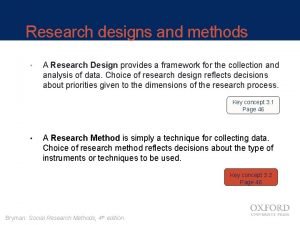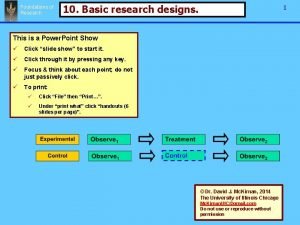Quantitative and Mixed Research Designs V Darleen Opfer














- Slides: 14

Quantitative and Mixed Research Designs V. Darleen Opfer

Design Task A principal/head teacher wants to know whether the provision of professional development will improve the instructional practices of teachers. Design a study for answering her question. In your design, address the following questions: n. What is the unit of analysis? (Will you focus your study on individual teachers, on subject area, on year levels, on the school as a whole? ) n. What is the design chosen for the study? How will you collect your data? n. What are your variables? (What are will you be measuring? )

Conditions for Establishing Cause. Effect Relationships: n Covariation n Temporal Precedence n No Plausible Alternative Explanations

Types of Alternative Explanations n n n n History Testing Instrumentation Regression Mortality Maturation Selection by maturation interaction Ambiguity about causal direction n Diffusion of treatments n Compensatory equalization of treatments n Compensatory rivalry n

Ways to Minimize Threats to Validity: n By argument n By measurement or observation n By analysis n By preventive action n By design

Basic Design Elements n Time n Program(s) or Treatment (s) = X n Observation(s) or Measure(s) = O n Groups or Individuals = Randomly assigned groups

An Example: R O X O O

Expanding a Design: X O n Expanding across time n Expanding across programs O O X 1 O O X 2 O Expanding across observations O 1 O 2 X O 1 O 2 n Expanding across groups R O X O R O O N O O _______________ R O X O R O O N O O n

An Expanded Example The cause-effect relationship X O n The comparison on achievement O X O O O n The expanded design C O X O R O O C O O n

A Strategy for Design Construction n n Depict the hypothesized causal relationship Identify the possible alternative explanation threats Over-expand the basic design by expanding across time, program observations, and groups accounting for as many alternative explanations as possible Scale back the design to a manageable plan by considering the effect of eliminating each design component

Mixed Designs n Mixed Model Research – Within-stage mixed model research – Across-stage mixed model research

Mixed Designs n Mixed Method Research

The Nature of Good Design n Theory-Grounded n Situational n Feasible n Redundant n Efficient

Design Task A principal/head teacher wants to know whether the provision of professional development will improve the instructional practices of teachers. Design a study for answering her question. Reconsider your design, address the following questions: n. What are your variables? (What are will you be measuring? ) n. If you’ve used a mixed method design, is it mixed model or mixed method? Concurrent or sequential? n. What are potential validity/alternative explanation issues with this study? n. What are the validity issues accounted for in your approach? And how would you minimize those not accounted for in the design?
 V. darleen opfer
V. darleen opfer Opfer rune
Opfer rune Empirical approach
Empirical approach Quasi experiment disadvantages
Quasi experiment disadvantages Quantitative descriptive correlational design
Quantitative descriptive correlational design What is a research design
What is a research design Darleen fisher
Darleen fisher Darleen fisher
Darleen fisher Mixed bags designs catalog
Mixed bags designs catalog Discuss descriptive and casual research designs
Discuss descriptive and casual research designs Cross-sectional correlational design
Cross-sectional correlational design Chapter 10 qualitative research designs
Chapter 10 qualitative research designs 2 types of research
2 types of research Basic research designs
Basic research designs Chapter 10 qualitative research designs book
Chapter 10 qualitative research designs book


























